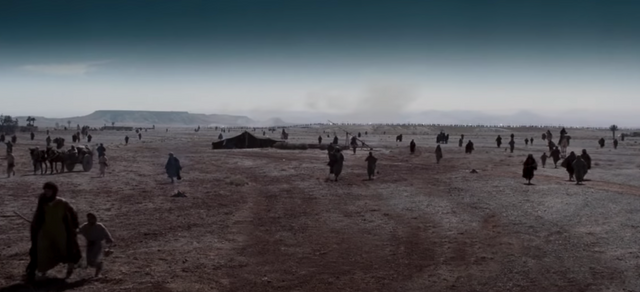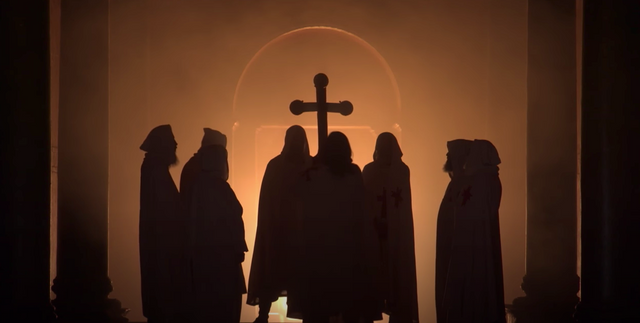The Templar Order - Classical Program Music that tells a story!

Bring the stories of the Knights Templar to life with this dramatic programmatic work! This animating storyline, filled with powerful fanfares, intense themes, and a breathtaking Gregorian chant-like ballad haunts us with tales of raiders, faith, and conquest that led to the formation of history's most notable order of knights.
I've worked on this piece for a little over a month. This is also published on the major music retailer, JWPepper, the link which you can find here: https://www.jwpepper.com/The-Templar-Order/11210839.item#.XtwUulqSG6U.link
The Idea for The Templar Order came from my experiences at my first part-time job at Medieval Times Dinner & Tournament and also from watching extensive documentaries on the crusades. The composition itself acts as a program piece, outlining a story based on the origins of the Poor Fellow-Soldiers of Christ and of the Temple of Solomon.
To set the stage, the piece begins with a percussive attack and pedal playing by the low brass, harmonizing with a Gregorian chant-like singing from the ensemble. Then we are quickly introduced to a grand fanfare, first by the brass and then followed by the woodwinds. This fanfare will come again later in the piece.

https://international.la-croix.com/news/being-a-pilgrim-in-the-holy-land/6308#
The music then transitions into a slow dragging-like subject, symbolizing the dangerous background of the Holy Land; from the deserts, to the hot heat of the sun, and to the long-distance environment between civilizations. It acts like a prerequisite to the storyline as we enter the main subjects of the story.

Scene from the movie, the Kingdom of Heaven.
We then enter a brisker development of this dragging-like subject. Congas and percussion playing a desert-feel rhythm pattern, accompanied by the low brass. We are also introduced to a shortened excerpt of Gregorian chant played by the trumpets. This chant will be revisited again later in the composition. The excerpt is also joined by a flurry of solos from the clarinet, piccolo, and alto sax in a free-like manner. The music here represents the various caravans of pilgrims from Europe, all with their own reasons for traveling to the Holy Land. The theme is lighter, almost danceable.

Scene from the Smithsonian Channel Series: Sacred Sites: Templars
Suddenly, the music turns eerie and suspenseful. The high woodwinds are playing trills while the low brass and woodwinds play a dark booming of notes. Sporadic chords come out of nowhere. And then the music shouts and blasts into an aggressive and war-like theme. The low brass plays large and violent chorales, introducing us to the exposition of this section. The music is filled with thunderous percussion and violent fluidity. This is representing the pilgrims being attacked by local raiders who are seeking to plunder the unprepared victims.

Scene from the movie, The Kingdom of Heaven
There is a small section of music that is more notably calmer than the rest of the section: While some try to fight back with whatever tools they had, some try to hide or run away. But the music quickly turns violent again. This was a dangerous time for travelers.

Scene from the Smithsonian Channel Series: Sacred Sites: Templars
As the music resolves to a darker tone, stories of these perils reach back to Europe and Jerusalem. Prayers spread and vocations are called as the music changes from war-like music to solemn chants. It’s a cry for something to change.

Scene from the Smithsonian Channel Series: Sacred Sites: Templars
This next section is completely different from the rest of the music as it is more poetic than it is storytelling. Nevertheless, it plays an important part in the story. History tells of nine knights who came together to form an order whose mission was to protect pilgrims on their way to the Holy Land. This formation is symbolized by the power of prayer and song.

Picture from: http://gregorian-chant-hymns.com/hymns-2/salve-regina-monastic.html
This ballad begins with the band singing a short excerpt of an old templar version of the Gregorian chant, the Salve Regina. Then, as if the heavens have opened up, the music changes from minor to major, dark to light. The chant itself has turned instrumental and the music has changed to its most known form.

Picture from: http://gregorian-chant-hymns.com/hymns-2/salve-regina-simple.html
Many Christians know this current form as the most formal arrangement of the Salve Regina, and legend says that the chant was given to a Catholic monk, named St. Herman Contractus, by a choir of angels.

Scene from the History Channel Series, Knightfall.
While historians don’t know exactly where the origins of this formal chant came from, none underestimate its powerful meaning and the inspiration it gives off. My only hope is that I gave justice to this extraordinary hymn.

Scene from the History Channel series, Knightfall.
The piece then transitions into a suspenseful march. The snare begins an ostinato theme and it slowly adds more depth by a complement of additional instruments. This is the start of the Knights Templar’s mission. Led by faith and with the support of the Church, the nine knights set out to protect new pilgrims on their way to the Holy Land. And as they journey, they encounter a caravan of pilgrims being attacked by a band of raiders.

Scene from the History Channel Series, Knightfall.
This small transition quickly returns to the war-like subject, except it’s more violent. There is more percussion, more rhythms, and additional small countermelodies from the trumpet and horns. The countermelodies played by the trumpets and horns are small hidden variations of the grand fanfare from the beginning. The large chorale also returns with slightly more violent percussion. The music here visualizes the knights catching the attackers off-guard as they rush towards the caravan. The battle begins as these Christian warriors fight to protect the defenseless travelers.

Scene from the History Channel Series, Knightfall.
All of a sudden, the music stops. A bass drum plays an ostinato like a heartbeat. Then the timpani dramatically rise and brings us back to that powerful fanfare from the brass an ending with an ambitious major chord. The knights won the battle and the raiders fled. With the success of their first battle, these proud knights formally begin their mission to protect incoming pilgrims from raiders. Thus, the Poor Fellow-Soldiers of Christ and of the Temple of Solomon was formed. Better known as the Knights Templar.
If possible, please share this as much as you can! One of the troubles as an unknown composer is that it's hard to get yourself recognized in this big of an industry. I would greatly appreciate it if you could share this with your friends! Especially music teachers and your local ensemble directors! Thank you!
Now, without further ado, I am proud to present to you this Grade 5 difficulty level concert piece: The Templar Order!